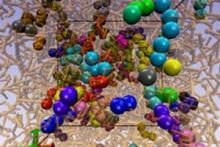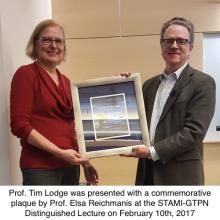

Collective motion and relaxation in glass-forming polymeric liquids are investigated in molecular dynamics (MD) simulations of bulk polymer, thin polymer film and nanocomposite materials. The physical arguments underlying the Adam-Gibbs (AG) model of glass-formation are summarized and we then test whether collective particle exchange motion exists as predicted by AG and whether this model can rationalize the highly variable temperature dependence of the structural relaxation time found in this broad family materials. We observe string-like excitations involving particles undergoing collective exchange motion that we directly identify with with the abstract “cooperatively rearranging regions” of AG (see figure below and Refs. 1 - 3 for discussion). Further, we verify this correspondence by quantitatively describing all our relaxation data based on our extended AG model (string model of glass-formation) and the empirically determed high tempearture Arrhenius activation parameters of transition state theory. Finally, we confirm the predicted inverse relation between the mass of the dynamic strings and the fluid configurational entropy that underlies the AG model. The implications of this model extend far beyond glass-forming polymer liquids; we show the same type of collective motion arises in grain boundaries of crystalline materials, the interfaces of crystals, the interfacial dynamics of nanoparticles, superheated crystals, and in biologically relevant materials such lipid membranes and the internal dynamics of proteins and arises in materials ranging from metallic glasses to polymer materials. Evidently, string-like collective motion is relevant to understanding relaxation in diverse condensed materials.


This lecture focuses on the challenging design, realization, understanding, and implementation of new materials families for unconventional electronics. Fabrication methodologies to achieve these goals include high-throughput, large-area, high-resolution printing techniques. Materials design topics will include: 1. Rationally designed high-mobility p- and n-type organic semiconductors for printed organic CMOS, 2. Self-assembled high-k nanodielectrics enabling ultra-large capacitance, low leakage, high breakdown fields, minimal trapped interfacial charge, and device radiation hardness, 3. Polycrystalline and amorphous oxide semiconductors for printable transparent and mechanically flexible electronics, 4. Combining these materials sets to fabricate a thin-film transistor-based circuitries, 5. The relevance of these advances to unconventional photovoltaics.

The Jarzynski research group focuses on statistical mechanics and thermodynamics at the molecular level, with a particular focus on the foundations of nonequilibrium thermodynamics. They have worked on topics that include the application of statistical mechanics to problems of biophysical interest; the analysis of artificial molecular machines; the development of efficient numerical schemes for estimating thermodynamic properties of complex systems; the relationship between thermodynamics and information processing; quantum and classical shortcuts to adiabaticity; and quantum thermodynamics.

Wigner lattices are nearly defect-free, and they are formed through repulsive interactions exclusively. The absence of defects inhibits melting, making the crystal much more stable, and it reduces the energy difference between crystal and liquid. Thus, the melting transition acquires a distinct second-order character, even though it is strictly a first-order transition. This form of melting was first proposed by the German physicist Max Born nearly 80 years ago. It is only now that its study can be carried out. Reception to follow the Lecture


Ionic liquids are an emerging class of solvents with an appealing set of physical attributes. These include negligible vapor pressure, impressive chemical and thermal stability, tunable solvation properties, high ionic conductivity, and wide electrochemical windows. In particular, the non-volatility renders ionic liquids practical components of devices, but they require structure-directing agents to become functional materials. Block polymers provide a convenient platform for achieving desirable nanostructures by self-assembly, with lengthscales varying from a few nanometers up to several hundred nanometers. Furthermore, ionic liquids and polymer blocks can be selected to impart exquisitely tunable thermosensitivity, by exploiting either upper or lower critical solution transitions (UCSTs and LCSTs).

